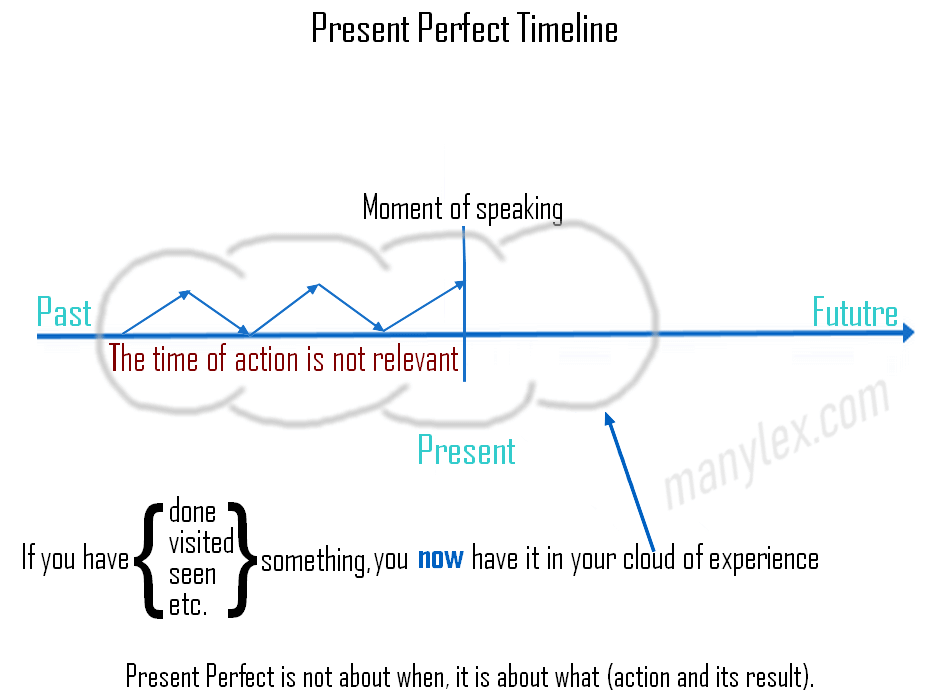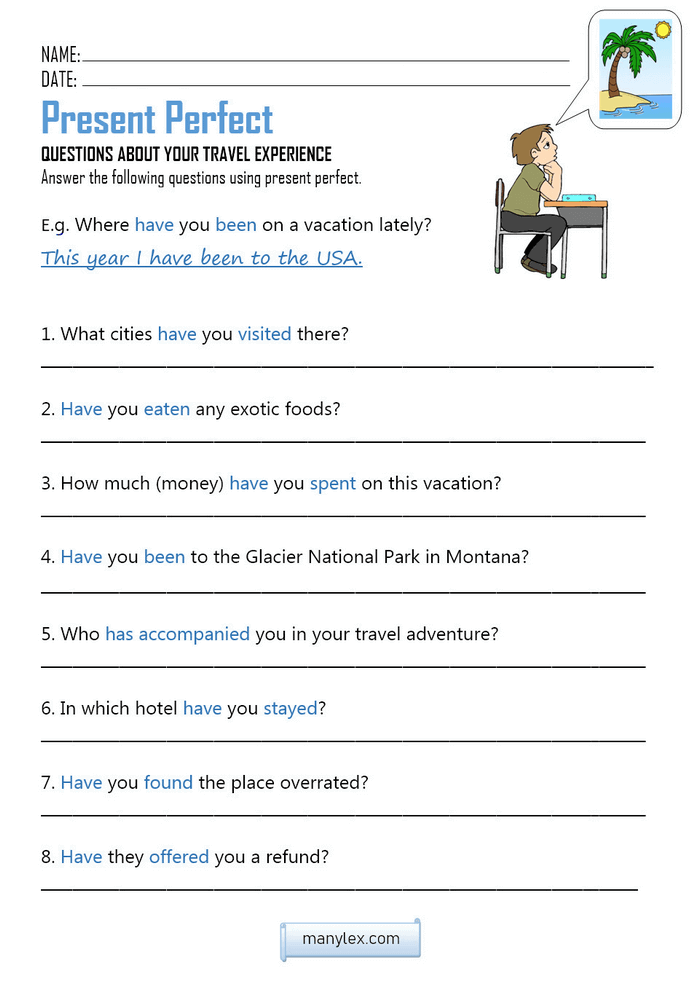Teaching Present Perfect Outside the Box
The present perfect tense is used to describe past experiences or actions when the time is unknown or irrelevant at the time of speaking. For example I’ve been to Germany – at this point when you went to Germany is unknown to the listener. (When the time is specified we use the Past Simple.) Why do we use “have” as an auxiliary verb in the Present Perfect? Is it just a matter of chance, or is there some logic behind it?
Let's look at the Present Perfect from the perspective of possession. Indeed, the verb “to have” means that someone or something owns a particular thing, quality, or feature. The auxiliary verb can also be interpreted as an indicator of possession. Nope, I am not mistaken. Getting to the bottom of this lesson plan, you will comprehend this concept and learn how it can help you teach Perfect Tenses to your students.
Important remark:
We have designed this lesson plan (so now we have it) for teaching the Present Perfect, but some of its parts can also be used for understanding and teaching all perfect tenses.
| Lesson Plan for Teaching Present Perfect Tense | |
| Name: | [Teacher’s name] |
| Date: | 08/09/20…. |
| Lesson Focus: | Focus on grammar |
| Level: | A2 (Late basic) |
| Age group: | Adults – General English |
| Number of students | 15 adults |
| Length: | 75 minutes |
| Lesson Objective: | By the end of the lesson, students will be able to speak about their real or imaginary vacation experience using the present perfect tense. |
| Materials: |
|
| Stage/Timing | Stage Objective | Teacher’s Actions | Students’ Actions | T/S Ratio and interaction | Comments |
|
Warm up/Review 8 minutes Elapsed time 8 minutes |
To reduce affective filter and increase students’ engagement. Review previously learned vocabulary. Recall use of have as a main verb. |
Hand out 15 blank cards and ask a volunteer to say what he or she has. (Expect: I have a blank card). Invite students to draw some fruit or vegetable on their card and write a title for it. Time limit: 3 min. Ask each student to show their work to the class and say
what they have and what their neighbor has. Write example
on the board:
|
Draw fruit or vegetable. Raise their pictures and say what they have. | CW 20/80 |
|
|
Lead-in 10 minutes Elapsed time 18 minutes |
Review some previous knowledge to help students understand the idea of upcoming explanation. |
Ask students to recall some uses of the verb to have and to give examples in a sentence.
Allow students to think of their examples.
If students hesitate or don’t have any ideas, write on the board in two colors:
More examples, if needed: Teacher: As you can see, the verb to have has not just one meaning. However, there is one more role of it in a sentence and this is an auxiliary verb. Auxiliary means helping and it will come in handy soon. Pre-teach vocabulary (See supplement). |
Try to recall uses of have and think of some examples. Learn vocabulary. |
CW 40/60 |
|
|
Introduction 2 minutes Elapsed time 20 minutes |
Introduction of today’s class objective (The Present Perfect Tense) | Teacher: Today we are going to speak about your vacation activities and habits using Present Perfect (PP). Then we’ll try to work out a rule for this tense. |
|
CW 100/0 |
|
|
Presentation 20 minutes Elapsed time 40 minutes |
Explain the grammar rule in the meaningful context. |
Teacher: Before we can proceed to your vacation, let’s get back for a moment to your pictures. We’ll need the verb to draw. As you already know, this is an irregular verb. Who can tell me the three forms of it (present, past, and past participle)? Elicit: draw, drew, drawn. Ask a volunteer to write it on the board. Now think about your fruit and vegetables. Are they real or…? Try to define them using Past Participle of the draw.
Expect responses (prompt if needed):
Teacher: Can you say: I have a
drawn apple? (Yes, I can.)
Can we rephrase the sentence in some way?
Try to elicit answer or help them: Yes, we can rephrase it, e.g.:
Draw the timeline on the board and explain what it means. (Materials: 3 and supplement). Now you know where the PP comes from. However, its use is much broader (examples written on the board before the presentation):
Important: the time of action, described with the Present Perfect is not relevant. The focus is on what, not on when. Here is another example of the affirmative sentence:(+) Affirmative: The train has already arrived. Can you turn it into negative and interrogative PP? Elicit answers: (–) Negative: The train has not arrived yet. (?) Interrogative: Has the train arrived yet? Now let’s look at the examples above and try to find some patterns. Prompt as needed: (+) SUBJECT + HAVE/HAS + PAST PARTICIPLE OF THE VERB(–) SUBJECT + HAVE/HAS NOT + PAST PARTICIPLE OF THE VERB (?) HAVE/HAS + SUBJECT + PAST PARTICIPLE OF THE VERB Remind students about the short forms (contractions):
|
Listen and participate by offering suggestions. Answer questions, think of examples. Try to work out a grammar rule (with teacher’s support). | CW 50/50 |
Write examples on the board before beginning the presentation. If a teacher doesn’t speak students’ L1 or if the class is international, make sure to use simplified language for explanations, also employ mime, gestures, and expression. |
| Practice and Application 20 minutes Elapsed time 60 minutes |
|
Teacher: And now we are going to talk about your vacation activities and habits, at last! Divide class into pairs and hand out a worksheet with questions about vacation to each group. Challenge them to interview each other using the following questions:
|
Practice speaking and ask questions about their vacation using present perfect in full and contracted form. | GW/PW 10/90 | Mind the odd number of students, play the role of collocutor for one of them. |
|
Monitoring and evaluation 8 minutes Elapsed time 68 minutes |
To make sure every student has understood the uses of Present Perfect for communication. | Allow students to ask each other simple questions using PP, monitor their answers, make corrections if needed. No functions to test, only a topic. Ask students if they have any questions. |
|
CW 50/50 |
|
|
Video 5 minutes Elapsed time 73 minutes |
Watch and discuss short video to complement students’ knowledge. | Watch and briefly discuss the VOA video (Supplement: 5). Draw students’ attention to the difference between adverbs used with the Present Perfect and the Past Simple tenses. |
|
CW 50/50 | Tell students that we watch this video for illustrative purposes. |
|
Home assignment 2 minutes Elapsed time 75 minutes |
|
Hand out photocopies of home assignment and explain what they have to do. (Material: 5 and supplement). |
|
CW 100/0 |
|
Lesson Plan Supplement
1. The Present Perfect Timeline Diagram

2. Vocabulary
- perfect adj. – without fault or defect; However, in the name of a tense, it means complete.
- auxiliary adj. – offering or providing help
- vacation n. – a period spent away from home or business in travel or recreation
- exciting adj. – producing excitement; stirring; thrilling
- impress v. – to affect especially forcibly or deeply
- to come in handy phr. – to become useful or helpful for something
3. Irregular Verbs (Review)
- draw, drew, drawn
- fly, flew, flown
- drive, drove, driven
- see, saw, seen
- do, did, done
4. Used Abbreviations
- CW — Class Work
- GW — Group Work
- PW — Pair Work
- T/S — Teacher/Student (talking time)
- PP — Present Perfect
5. Present Perfect Home Assignment Worksheet
